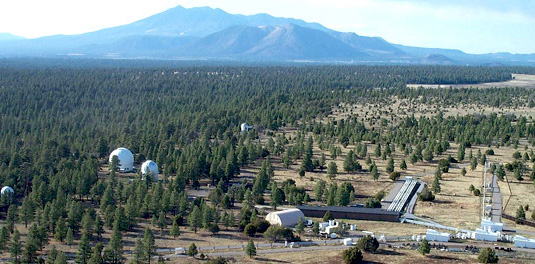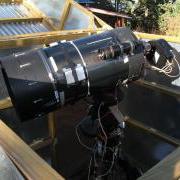
Site
Latitude and longitude: 35°05′49″N 111°32′09″W (+35.0969, -111.5358)
Elevation: 2,163 meters (7,096 ft)
Site manager: Stephen Levine
Internet access:
Weather statistics:
Typical good seasons:
Wright 28 (W28) Donated by the late Paul Wright
Telescope
Type: Celestron C11 Schmidt-Cassegrain
Aperture: 280mm
Focal length: 1717mm
F-ratio: 6.13
Focuser: Moonlite (www.focuser.com) motorized focuser, 2” diameter drawtube.
Mount
Pointing accuracy is typically 1 – 2 arcminutes 'in the blind', but after a plate solve/reslew pointing error is reduced to 20 arc seconds or less. Maximum unguided tracking restrictions, if any: 60 seconds
Computer: PC/Win XP
Software: Maxim for CCD/filter wheel control. TheSky6Pro/TPoint for scope control and pointing model. FocusMax for focuser control. ACP and ACP Scheduler for overall system operation.
Telecope Advocate: Sara Beck
Imaging
Typical seeing: 2.8 arc seconds FWHM
Best seeing: 2.0 arc seconds FWHM
Vignetting:
Scattered light: After flat fielding, photometric errors are at the 1 – 2% level across the entire field. (Arne has verified this with raster scan multi-image tests.)
Image defects: None
Camera
Type: SBIG ST-7XME
Filter wheel: SBIG CFW-10
Filters: C B V R I Ha Sii Red645NM Sloan g' Sloan r'
Exposure ratios/filter: C=0.25 B=3.0 V=1.0 R=0.55 I=1.1 HA=14 Sii=15 Red645NM=13 Sloan g'=1.1 Sloan r' =0.55 (Note – if your target is a very red star, expect to shorten R and I exposures and lengthen B exposures...assuming V exposures remain constant.)
Pixel count: 765 x 510
Pixel scale: 1.08 arcsec/pixel
Field of view: 14 x 9 arc minutes
Gain: 2.5e-/ADU
Readnoise: 19e-
Full well: Above 44,000 ADU response is not linear
Cosmetic defects: None
Dark current: 1e-/sec/pix at 0C typical
Read time: 3 seconds
Shortest exposure: 0.11 sec
Compressed image size: 330KB
Typical images
| Star Image | Flat | Bias Frame | Dark Frame |
|---|---|---|---|
 |
 |
 |
 |
Typical use of system
Multi-filter 'snapshot' coverage once a night for many targets, or long time-series of a small number of targets, or a mixture of the two.
Miscellaneous notes
Calibrated images are 16-bit, but can have negative values, and non-integer values. You may have to set up your photometry software to specifically deal with this situation (some software deals with it automatically, some does not).


